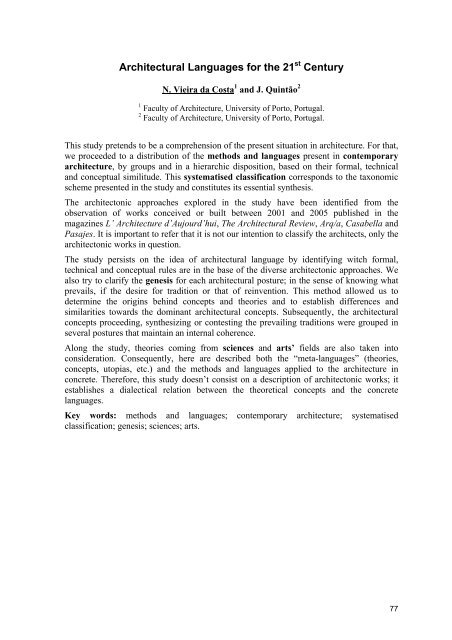IJUP08 - Universidade do Porto
IJUP08 - Universidade do Porto
IJUP08 - Universidade do Porto
- TAGS
- universidade
- porto
- ijup.up.pt
You also want an ePaper? Increase the reach of your titles
YUMPU automatically turns print PDFs into web optimized ePapers that Google loves.
Architectural Languages for the 21 st Century<br />
N. Vieira da Costa 1 and J. Quintão 2<br />
1 Faculty of Architecture, University of <strong>Porto</strong>, Portugal.<br />
2 Faculty of Architecture, University of <strong>Porto</strong>, Portugal.<br />
This study pretends to be a comprehension of the present situation in architecture. For that,<br />
we proceeded to a distribution of the methods and languages present in contemporary<br />
architecture, by groups and in a hierarchic disposition, based on their formal, technical<br />
and conceptual similitude. This systematised classification corresponds to the taxonomic<br />
scheme presented in the study and constitutes its essential synthesis.<br />
The architectonic approaches explored in the study have been identified from the<br />
observation of works conceived or built between 2001 and 2005 published in the<br />
magazines L’ Architecture d’Aujourd’hui, The Architectural Review, Arq/a, Casabella and<br />
Pasajes. It is important to refer that it is not our intention to classify the architects, only the<br />
architectonic works in question.<br />
The study persists on the idea of architectural language by identifying witch formal,<br />
technical and conceptual rules are in the base of the diverse architectonic approaches. We<br />
also try to clarify the genesis for each architectural posture; in the sense of knowing what<br />
prevails, if the desire for tradition or that of reinvention. This method allowed us to<br />
determine the origins behind concepts and theories and to establish differences and<br />
similarities towards the <strong>do</strong>minant architectural concepts. Subsequently, the architectural<br />
concepts proceeding, synthesizing or contesting the prevailing traditions were grouped in<br />
several postures that maintain an internal coherence.<br />
Along the study, theories coming from sciences and arts’ fields are also taken into<br />
consideration. Consequently, here are described both the “meta-languages” (theories,<br />
concepts, utopias, etc.) and the methods and languages applied to the architecture in<br />
concrete. Therefore, this study <strong>do</strong>esn’t consist on a description of architectonic works; it<br />
establishes a dialectical relation between the theoretical concepts and the concrete<br />
languages.<br />
Key words: methods and languages; contemporary architecture; systematised<br />
classification; genesis; sciences; arts.<br />
77










